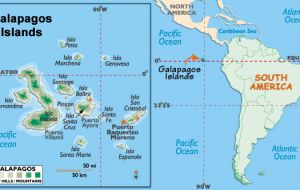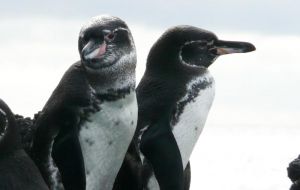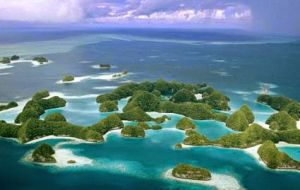MercoPress. South Atlantic News Agency
Galapagos penguin numbers recovering with shifts in trade winds and ocean currents
 The Galapagos Islands, a chain of islands 1,000 kilometers west of mainland Ecuador, are home to the only penguins in the Northern Hemisphere.
The Galapagos Islands, a chain of islands 1,000 kilometers west of mainland Ecuador, are home to the only penguins in the Northern Hemisphere.  The black and white Galapagos Penguins landed on the endangered species list in 2000 after the population plummeted to only a few hundred individuals
The black and white Galapagos Penguins landed on the endangered species list in 2000 after the population plummeted to only a few hundred individuals  Most live on the archipelago's westernmost islands, Isabela and Fernandina, feeding on fish that live in a cold pool of water along the southwestern coasts.
Most live on the archipelago's westernmost islands, Isabela and Fernandina, feeding on fish that live in a cold pool of water along the southwestern coasts. Shifts in trade winds and ocean currents powered a resurgence of endangered Galapagos Penguins over the past 30 years, according to a new study led by researchers at the Woods Hole Oceanographic Institution (WHOI). These changes enlarged a cold pool of water the penguins rely on for food and breeding-an expansion that could continue as the climate changes over the coming decades, according to the study.
The Galapagos Islands, a chain of islands 1,000 kilometers west of mainland Ecuador, are home to the only penguins in the Northern Hemisphere. The 48-centimeter tall black and white Galapagos Penguins landed on the endangered species list in 2000 after the population plummeted to only a few hundred individuals and are now considered the rarest penguins in the world.
Most of the penguins live on the archipelago's westernmost islands, Isabela and Fernandina, where they feed on fish that live in a cold pool of water on the islands' southwestern coasts. The cold pool is fed by an ocean current, the Equatorial Undercurrent, which flows toward the islands from the west. When the current runs into Isabela and Fernandina, water surges upward, bringing cold, nutrient-rich water to the surface.
New research suggests shifts in wind currents over the past three decades, possibly due to climate change and natural variability, have nudged the Equatorial Undercurrent north. The changing current expanded the nutrient-rich, cold water farther north along the coasts of the two islands, likely bolstering algae and fish numbers in the cold pool. This allowed the penguin population to double over the past 30 years, swelling to more than 1,000 birds by 2014, according to the new study.
Climate change could further shift wind patterns and ocean currents, expanding cold water further north along the coasts of Isabela and Fernandina and driving fish populations higher, according to the new study.
Penguins, as well as other animals like fur seals and marine iguanas that feed and reproduce near the cold waters, may increase in numbers as the northwestern coasts of the islands become more habitable, said the study's authors. They noted that wind and ocean currents could also return to earlier conditions, leading to a decline in penguin populations.
“The penguins are the innocent bystanders experiencing feast or famine depending on what the Equatorial Undercurrent is doing from year to year,” said Kristopher Karnauskas, a climate scientist who performed the research while at WHOI, and lead author of the new study recently accepted in Geophysical Research Letters, an American Geophysical Union journal.
The new findings could help inform conservation efforts to save the endangered penguins, said the study's authors. Increasing efforts on the northern coasts of the islands and expanding marine-protected areas north to where the penguins are now feeding and breeding could support population growth, the study's authors said.
Karnauskas notes that the vast majority of marine organisms will be negatively affected by the rise in ocean temperatures and acidification that are expected to occur across the globe as a result of climate change.
“With climate change, there are a lot of new and increasing stresses on ecosystems, but biology sometimes surprises us,” said Karnauskas. “There might be places-little outposts-where ecosystems might thrive just by coincidence.”
The Galapagos Penguin population tenuously hangs onto the islands that so enthralled Charles Darwin during his visit in 1835. The penguins once numbered around 2,000 individuals, but in the early 1980s a strong El Nino - a time when sea surface temperatures in the tropical Pacific are unusually warm - brought their numbers down to less than 500 birds. Dogs, cats and rats introduced to the islands also stymied the penguin population by attacking the birds, disturbing their nests, and introducing new diseases, according to previous research.
Despite these setbacks, the penguins gradually increased in number in the following decades, according to local bird counts. Researchers, interested by the increase in penguins, noted that the birds remained near the coldest stretches of water. Nearly all of the Galapagos Penguins live on the western coasts of Isabela and Fernandina, and two-thirds of them huddled near the coldest waters at the southern tips of the islands, according to previous research.
The study's authors wanted to know whether the growing numbers of penguins were related to local changes in ocean temperature. They combined previously-collected penguin population data from 1982 to 2014 with sea surface temperature data from satellites, ships and buoys for the same time period.
They found that the cold pool, where sea surface temperatures are below 22 degrees Celsius, expanded 35 kilometers farther north than where it was located at the beginning of the study period. In the 1980s the cold water pocket reached only the southern halves of the western coasts of Isabela and Fernandina. By 2014, the cold water pocket extended across the entire western coasts of the islands.
A shift in trade winds and underwater ocean currents likely caused the Galapagos cold pool expansion, propose the authors.
Trade winds blow surface ocean waters from the southern side of the equator to the northern side of the equator. As surface waters pile up in the north, the water at the bottom of the pile is squished south, nudging the Equatorial Undercurrent-a cold current that flows roughly 50 meters under the ocean surface-south of the equator.
Satellite images showed that this expanded pool of cold water likely encouraged the growth of phytoplankton, according to the new study. This increase in ocean algae attracted fish to the area- the main entrée for Galapagos Penguins, suggest the authors. The largest pulses of cold water reached the islands from July through December, coinciding with the penguins' breeding season. The bountiful fish helped the birds successfully reproduce and feed their young, according to the new study.




Top Comments
Disclaimer & comment rules-

-

-

Read all commentsI like penguins. Cute and harmless. Just wish to live in peace.
Aug 06th, 2015 - 02:41 am 0The should get the SA chair at the UN. They talk more sense than any of the recent incumbents.
“possibly due to climate change and natural variability” Spot the difference.
Aug 06th, 2015 - 10:00 am 0“Climate change could further shift wind patterns and ocean currents” Or natural variability could.
“They found that the cold pool, where sea surface temperatures are below 22 degrees Celsius, expanded 35 kilometers farther north than where it was located at the beginning of the study period. ”
So sea surface temperatures are decreasing, not increasing due to global warming.
“Karnauskas notes that the vast majority of marine organisms will be negatively affected by the rise in ocean temperatures and acidification that are expected to occur across the globe as a result of climate change.”
But he just told us that temperatures are getting colder.
“expected to occur ?”
Ocean acidification is another baseless scare as the climate fails to respond as claimed, to increasing CO2 levels. The oceans are not becoming acidic and will not do so.
1 asshole
Aug 06th, 2015 - 02:37 pm 0“I like penguins. Cute and harmless. Just wish to live in peace. ”
and yet YOU lot have massacred 5 millions of them in just 20 years, uh???
you hypocrite isleteer you
Commenting for this story is now closed.
If you have a Facebook account, become a fan and comment on our Facebook Page!